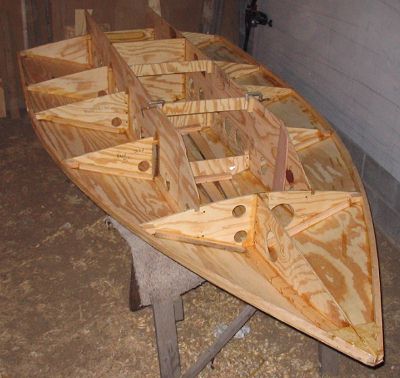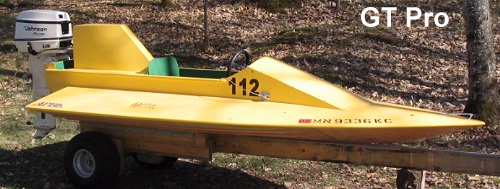 |

|
Dillon Racing -- The Dillon Mini Vee
The Vee was converted to GT Pro class in the spring of 2007. I started by narrowing the pad from eleven inches down to seven inches. Then I added a jack plate for vertical adjustment as well as a few more inches of set-back. The final step was to upgrade to 35hp and add hydraulic trim.
Early testing showed an increase in speed of about five to six mph -- with an aluminum, Mini GT propeller. (Stainless steel racing props will come later.) But the big improvement came in the turns. With the motor trimmed down, the Vee now turns like a dream, carves its way through just as smooth as you please.
I also added the fairing piece seen in the picture above, but only to provide a large vertical space for my boat number -- the original one was too small to be read from the scorer's table.
The Vee ran in seven GT Pro races (and four Mini GT) in 2007, and did so quite successfully.
And now I have drawn up the plans, and I they are for sale right now, right HERE.
The full Dillon Mini Vee story is below.
The Mini Vee project started in June, 2006, with some sketches on my computer. The sketches were meant only as a casual investigation into the possibility of designing a V-bottom Mini GT racing boat sometime in the future. But the sketches lead to some scale drawings, which lead to some full-size cross-sectional drawings, and then the realization that I could build one of these fairly quickly, even race it before the 2006 racing season was over.

Next thing I knew, the Dillon Mini Vee was under construction. I used only AC grade plywood from the local lumberyard, glued it all together with epoxy, finished the bottom with clear epoxy and the rest with latex housepaint.
First launch came on August 3. It jumped smoothly onto plane and rode high on its pad. But it quickly became clear that this boat did not want to turn in any kind of a reasonble manner.
I got advice from Jerry Sellner, several-time Formula V national champion (and national speed record holder), and Howard Pipkorn, founder of Hydrostream. An addition to the bottom, and addtional racing and testing, utimately solved the problem. The results are discussed in the Mini Vee Online Construction Notes.
The Mini Vee is 11'10" long and 60" wide. The empty hull weight is 165 lbs. To bring it up to the Mini GT minumum weight of 600 lbs. (incuding motor and driver), I added 70 lbs. of ballast.
Watch a video of the Dillon Mini Vee in action. (Sorry for the poor quality.) Click the link to play, or right-click the link and then save it to your computer (approx. 4.4 megs).
Despite all the difficulties, the Mini Vee ran in four Mini GT races in 2006. The first two were driven by Dominick Kuhl at Moose Lake, MN. Then in October, I got behind the wheel myself. I filed the following report....
* * * * *
October 21 and 22
With the 2006 Mini GT highpoints championship firmly in my grasp, I decided to use the October 2006 "Snowflake Race" in Little Falls, MN, to give the Dillon Mini Vee the full race test. Here's what happened, and what I learned.
I started heat #1 on the outside position in a five-boat field. Tyler Kuhl, driving the Dillon Mini Tunnel, had the pole and quickly shot out in front, never to be seen again. I came out of turn one side-by-side with David Sellner in his V-bottom Critchfield. Here I learned that the Mini Vee was faster than the Critchfield. But the Vee was suprisingly tough to control in the rough water, and David had the inside line, so he quickly pulled ahead at the next turn. I also had a terrible time in the turns -- no surprise there -- but managed to hold the third position.
I had the pole for heat #2, but that didn't prevent Tyler from grabbing the lead again. I came out of the first turn in second place with David nowhere in sight. A couple of laps were down before I realized he was back at the dock with engine trouble.
The Mini Vee continued to give me fits in the rough water, repeatedly getting out of control and clearly too light in the bow. I tried to take the turns as fast as I could, but probably lost more time backing away from the mess that caused. Driving the Vee was proving to be a wrenching, pounding chore, with no fun in sight.
With all my troubles, Stephanie Hansen, finding her groove at the end of her rookie season, snuck inside and passed me. It didn't matter that I had the faster boat. With no control, I was toast.
The race was won by Tyler in the Dillon Mini Tunnel; second to Stephanie; and third place going to the Dillon Mini Vee.

Sunday morning I moved a thirty pound weight from the stern to the bow, hoping to gain some control. Wow, what a difference. This completely tamed the boat on the straightaways, maybe too much. There will be room to experiment there. It didn't help in the turns, however, so I took another approach. I simply slowed way down as I approached the buoys, then pushed the throttle back to the floor as I steered into a smooth, banking turn.
David's motor died before the race began, so only four of us lined up for the start. Tyler again jumped into the lead, and I took up second position. I held back on the straighaways to keep Stephanie Hansen and Katie Sellner close behind. Although I had no intention of giving up any positions, Stephanie made an aggressive move to the inside and snuck by me again. The heat ended with the Mini Vee in third place.
In heat #2, I started in the third position with Katie inside and Stephanie outside. As I struggled to make the first turn, Katie easily took the lead. Then Stephanie crossed my wake and shot ahead of me as well, leaving me in last place. The girls stayed pretty much side-by-side the rest of the way, effectively blocking any chance I might have had to regain position. Though I could pull up beside them on the straightaways, I didn't have a prayer in the turns. In the last dash for the finish line I moved to the outside in search of smoother water and the three of us finished in a tight group. But the Vee was still in fourth place, and that's how I finished overall as well. Results: Tyler, Stephanie, Katie and Me.
Despite the unimpressive results, the Sunday race demonstrated that the Dillon Mini Vee can be tamed, although more work is needed in the turns. The Sunday race was a lot more fun, too, and I'm looking forward to driving the Vee again next year.
Purchase Mini Vee Plans
The Evolution of the original Dillon Mini Vee
| ||
| Continue Shopping | ||
 | ||


